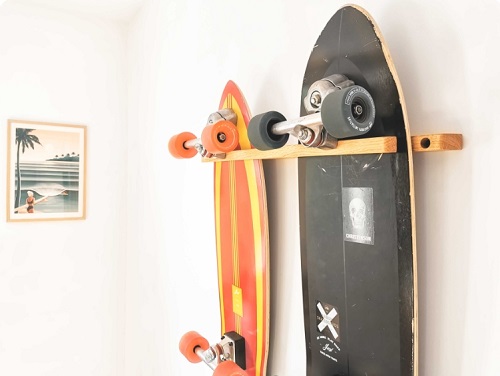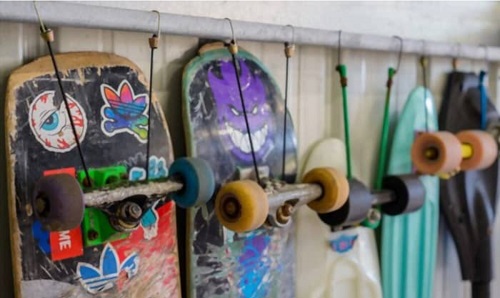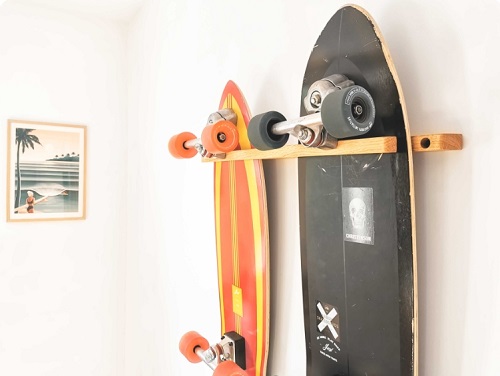Mounting a skateboard on your wall isn’t just about storage—it’s an opportunity to turn your deck into a statement piece. Whether you’re showcasing a prized skateboard from your collection, preserving a board filled with memories, or simply clearing floor space, mounting a skateboard can be both stylish and functional. This guide will take you through all the steps you need to know, from selecting the best tools and placement to mounting the board securely and avoiding common mistakes. Additionally, you’ll get creative tips on how to display multiple boards or unique designs. By the end of this article, you’ll be ready to hang your skateboard like a pro, ensuring it becomes a striking feature of your home’s décor. Let’s dive into how to mount a skateboard on your wall in a way that combines functionality with flair.

Why Mount Your Skateboard on the Wall?
Mounting your skateboard on the wall offers several practical and aesthetic benefits. For starters, it keeps your skateboard safe from potential damage, especially in homes where floor space is limited, and it doubles as a unique art piece that reflects your passion. Whether you’re a skateboarder or a collector, turning your skateboard into a display transforms it from a functional tool into a visual centerpiece. It’s also an easy way to declutter—getting your board off the floor or out of a corner while adding a personal touch to your room. Mounting skateboards on the wall is particularly appealing to collectors of limited-edition decks, allowing you to preserve their condition while still admiring them. In essence, mounting a skateboard on your wall is both a smart storage solution and a way to enhance your interior design.
What You’ll Need to Mount a Skateboard
Mounting a skateboard requires gathering the right tools and selecting an ideal wall for both security and visual appeal. Essential tools and materials include a drill, screws, and anchors—especially for drywall. Wall brackets or skateboard-specific mounts are recommended for a secure hold. For a no-drill option, heavy-duty adhesive strips can be used but are best suited for lightweight boards. A measuring tape, pencil, and level ensure proper alignment, preventing a crooked display. When choosing the right wall and placement, consider the wall type—drywall, brick, or plaster—and use suitable anchors to support the weight. Avoid areas with heavy foot traffic to reduce the risk of the board being knocked off. Placement near an entryway, above furniture, or in a home office can create an eye-catching display. Ensure there’s enough space for the board to be mounted without overcrowding, enhancing both security and room aesthetics.
Step-by-Step Guide: How to Mount a Skateboard on Your Wall
Mounting your skateboard can be a straightforward task when done correctly. Follow this step-by-step guide to ensure your board is securely and stylishly displayed.
Preparing Your Skateboard for Mounting
Before mounting, inspect your skateboard to ensure it’s in the best possible condition for display. Begin by cleaning the deck to remove any dirt, grime, or dust—this is particularly important if you’re showcasing a board you’ve ridden extensively. Use a damp cloth to clean both the deck and the wheels, or consider removing the wheels and trucks altogether for a sleeker, minimalist look. If your skateboard has graphic designs you want to highlight, make sure the mounting hardware won’t obstruct these areas. Depending on your style, decide whether you want to mount the skateboard vertically, horizontally, or at an angle. Each option has its visual advantages, with horizontal mounts showcasing the full deck design, and vertical mounts saving more space. Once your skateboard is prepped, you’re ready to move on to securing it to the wall.

Securing Your Skateboard to the Wall
Now that your skateboard is clean and ready for mounting, it’s time to secure it to the wall. If you’re using brackets, position them on the wall where the trucks of the skateboard will align. Use a pencil to mark where the screws should go, ensuring they’re level and properly spaced for the board’s dimensions. Drill small pilot holes at the marked points, insert wall anchors, and screw the brackets in place. For adhesive strip solutions, follow the manufacturer’s instructions, applying enough strips to securely hold the board’s weight. Once the mounting hardware is attached, gently place the skateboard onto the brackets or strips. Double-check that the board is level and firmly mounted before stepping back to admire your work. If it feels loose or uneven, make adjustments before proceeding.
Final Touches for a Secure and Stylish Display
With your skateboard mounted, take a moment to assess the display and make final adjustments. Ensure that the skateboard is level and securely fastened. If you’ve used brackets or hooks, check that they’re flush against the wall and holding the board without any wobble. For adhesive mounts, gently test the board’s security by applying slight pressure. Now is also the time to consider any aesthetic enhancements—perhaps you’d like to add accent lighting to highlight the board, or surround it with framed art, posters, or other décor. If you’ve mounted multiple skateboards, play with symmetry and spacing to achieve a visually appealing arrangement. These final touches help your skateboard display stand out, ensuring it functions both as a piece of art and a testament to your skateboarding passion.
Common Mistakes When Mounting a Skateboard and How to Avoid Them
Mounting a skateboard may seem simple, but common mistakes can impact both the appearance and security of your display. One frequent error is incorrect measurements and leveling. Failing to measure properly or use a level can result in a crooked display or an insecure mount. To avoid this, measure both the board and the wall space carefully, and use a level to ensure your marks and the mounted skateboard are perfectly straight. Another common issue is choosing the wrong wall type. Drywall, for instance, requires heavy-duty anchors, while brick or concrete walls need a hammer drill and masonry screws. Avoid mounting on weak or damaged walls, as this could lead to the skateboard falling or causing damage. By taking accurate measurements and understanding the type of wall you’re working with, you can ensure a secure and professional-looking skateboard display.
Creative Display Ideas for Skateboards
Once you’ve mounted your skateboard, you can get creative with how you display it to make it a standout feature in your space. Horizontal vs. vertical mounting offers different aesthetics: horizontal is perfect for showcasing the full design of your deck, especially above furniture, while vertical mounts are space-efficient, ideal for narrow walls, and can create the illusion of height. For a more dynamic look, try diagonal mounting. If you have multiple boards, creating a wall feature by arranging them in grids, staggered heights, or mixing horizontal and vertical orientations adds artistic flair. Group them by theme or color to make a cohesive statement. Finally, adding personal touches such as LED lighting, custom brackets, or painting the background enhances the display. You can even incorporate small shelves for accessories or frame your skateboard for a polished, gallery-like presentation. These creative ideas will showcase both your skateboarding passion and interior design skills.
Conclusion
Mounting a skateboard on your wall is an easy, rewarding way to merge practicality with creativity. By following the steps outlined in this guide, you can securely mount your skateboard, ensuring it becomes a focal point in any room. Whether you’re displaying a cherished board from your collection or simply creating more storage space, proper mounting techniques will guarantee a sturdy and stylish display. From choosing the right wall and hardware to deciding between horizontal and vertical orientation, every step is key to achieving a professional finish. You also have the freedom to get creative—by combining multiple boards, adding lighting, or using custom brackets, your display will reflect your unique style. Now that you know how to mount a skateboard on your wall, it’s time to start planning your own personalized display.
FAQs:
Can I mount my skateboard without drilling holes in the wall?
Yes, you can use heavy-duty adhesive strips or wall hooks designed for no-drill mounting, but ensure they are strong enough to support the skateboard’s weight.
How do I make sure my skateboard is securely mounted?
Use the right anchors for your wall type, and double-check that the hardware is firmly in place. Also, ensure the skateboard is level and stable before completing the installation.
What’s the best way to remove a skateboard from the wall without damaging it?
If you used screws, unscrew them carefully. For adhesive mounts, follow the product’s removal instructions to avoid damaging the wall or the skateboard.

